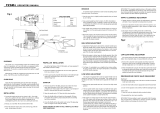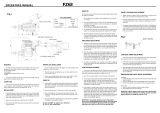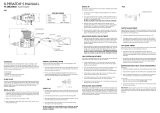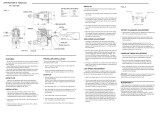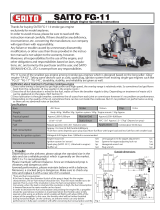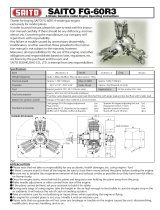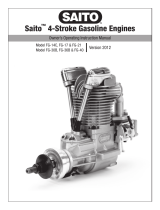
58
YS Fuel Filters (Not included)
Check Valve
Tube(B)
YS Fuel Filters (Not included)
63 25
111.5
128
Tube(A)
Front Nut
Rear Nut
SPECIFICATIONS
Bore 32mm
Stroke 29mm
Displacement 23cc
Weight 895g
Practical rpm 2,000-11,000rpm
FZ140-Sport OPERATORS MANUAL
Fig.1
FEATURES
The new FZ140 Sport uses the best features of our very success-
ful 120 and 140 engines, combined in an easy-to-operate and eco-
nomical package. It is ideally suited to aircraft which previously used
the YS120, as the mounting dimensions are the same. An added
bonus is that the weights are essentially equal, and the FZ140 Sport
will turn larger propellers for higher flight performance.
GLOW PLUG
Select the most appropriate glow plug from those designed
specifically for 4 cycle engines. Glow plug selection greatly affects
the maximum engine output and low idle. lf RPM’s decrease or stop
when the booster cord is removed, replace the plug. We recom-
mend YS #4 or OS Type F.
INSTALLATION
1. Connect the engine to the tank as shown in fig.1. Since high
pressure is applied to the tank, tighten all connections carefully.
Care must be taken to prevent pressure leakage due to under-
tightening of the check valve or by kinking the fuel lines.
2. Always use a fuel filter. We recommend theYS filter.
3. Match the direction of the check valve arrow to fig.1,with the
arrow facing towards the tank.
4. It is highly recommended that this engine be mounted on a
vibration absorbing soft mount.
PROPELLER INSTALLATION
Due to the high torque of the FZ140 Sport , we have equipped It
with double locknuts for safety.
1. Mount the propeller and tighten the rear nut. Next, tighten the
front nut as shown in Fig.1.
2. Select a good quality propeller that will turn in the 8,000 to 9,000
range, We recommend sizes 14x14 through 16x11
START UP
1. Remove tube B from the filter; remove tube A from the check
valve, then fill the tank. (CAUTION, If tank is filled or under-
pressure remove tube A first, then tube B. Fuel will eject if tube
B is removed while the tank is pressurized.)
2. Open the needle valve 2 1/2 from the fully closed position.
3. Open the throttle fully and slowly turn the propeller 10 times.
This primes the system by pressurizing the tank and sending
fuel to the carburetor.
4. Close the throttle to the idle position and connect the glow plug
cord. The engine is now ready for starting.
DO NOT ATTEMPT TO START AT FULL THROTTLE, AS THIS IS
VERY DANGEROUS.
BREAK-IN
To maximize engine performance and increase durability, please
follow this break- in procedure;
1. Use the same size (or slightly smaller) propeller than you intend
to use in flying.
2. Use a good quality fuel which contains 15-30% nitromethane
and oil content of 20-24%. Synthetic oil is recommended, or a
blend of synthetic oil and a small amount of caster oil may be
used. Do not use four cycle fuel due to low oil content.
3. The needle valve should be set so that the engine is running at
rich setting. Run the engine approximately 20 minutes with this
setting.
4. Mount the engine to the model and fly ten times with this setting.
This concludes the break-in procedure, It is advisable to always
use a slightly rich setting to keep the moving parts lubricated,
even atter the break-in period .
HIGH SPEED ADJUSTMENT
1. Adjustment of high speed is done by the carburetor needle valve.
When the needle valve is turned clockwise, the mixture is leaner.
When it is turned counterclockwise, the mixture is richer. A good
starting position for the high speed needle valve is 2 1/2 turns
open from the fully closed position.
2. When the engine is started, open the throttle graduall. Next, find
the peak position (highest RPM) by adjusting the needle valve.
Then the needle valve should be opened approximately 1/8 of a
turn from full RPM to achieve best performance. The engine may
stop if the throttle is opened to full immediately atter starting.
Wait until the engine temperature rises and then open the throttle
slowly.
3. For flying, it is advisable to use a slightly richer mixture setting.
By using a richer mlxture, the engine temperature is maintained
and RPM stability improves.
LOW SPEED ADJUSTMENT
This engine is equipped with a new low speed needle valve to
adjust the mixture from low to mid throttle. This needle valve is
located on the side of the throttle barrel opposite the throttle arm
(Fig.1)
1. Open the low speed needle valve to 1 1/2 turns from fully closed
position.
2. The low speed needle valve should be set after the high speed
needle valve has been adjusted. Close the throttle gradually to
an idle (approximately 2500rpm). Let it idle for 20 to 30 seconds
and then slowly advance the throttle. The adjustment is satisfatory
at low speed if transition is smooth at this time.
3. If the engine is runnlng rough on idle, the low speed mixture is
rich. If the engine starts to speed up and dies on idle or starts to
detonate, when advancing the throttle, the mixture is lean. Turn
the low speed needle valve clockwise to richen and
counterclocwise for a leaner mixture (note that the direction of
the low speed needle valve is opposite the high speed needle
valve). Adjustments to the low speed needle valve should be 1/8
to 1/4 of a turn increment at a time to achieve smooth throttle
response.
IMPORTANT! The regulator adjusting screw on this engine is fac-
tory set. No further adjustments are necessary. If for some reason
you have to disassemble the regulator assembly, the regulator
adjusing screw should be set flush with the regulator body.
TAPPET CLEARANCE ADJUSTMENT
1. Tappet clearance is factory preset. No adjustment is necessary
until atter 1 hour of operation (including break-in period).
2. Clearance adjustment should be done when the engine is cool.
When the engine temperature is high, clearance is higher due to
thermal expansion.
3. The proper clearance setting should be at 0.04-0.Imm.
The adjustment is achieved by loosening the locknut (Fig. 2) and
turning the adjusting screw. Tighten the locknut after the adjust-
ment is achieved. After the initial 1 hour adjustment, this proce-
dure should be performed after every 2 hours of use.
Fig.2
CAM GEAR TIMING ADJUSTMENT
If for some reason you have to disassemble your engine, please
follow these important steps on reassembling the cam gear.
1. Remove the carburetor and backplate assembly. Notice the
impression made on the crankshaft counterweight. Position it
directly straight down or in line with the case outer seam line.
2. When reinstalling the cam gear, the side with a point mark should
be facing the opening of the gear box, Note that it should also be
mounted with the point mark located towards the top of the
engine just below the cam followers.
DIAPHRAGM AND CHECK VALVE DISASSEMBLY
Diaphragm:
1. Remove the adjustment screw of the valve, and then remove the
inside valve and spring.
2. Clean the inside with alcohol or appropriate cleaner.Reassemble.
3. Screw in the regulator screw until flush with the diaphragm body.
Check valve;
1. Open the valve by rotating the body counterclockwise.
2. Reassemble the check valve carefully.
MUFFLER INSTALATION
We recommend mounting the muffler outside the cowling so that
proper cooling can be achieved. If the muffler is mounted inside the
cowling, extra cooling air is necessary to prevent muffler failure due
to excessive heat build up.
IMPORTANT! Silicone rubber is used in many parts of the YSengine.
Use only glow fuel or methanol for cleaning. Gasoline and other
volatile solutions will damage the silicone if used.
/ YS0093

WARRANTY
Strict quality control is implemented by our factory in all phases, from parts manufactiring
to final assembly. If performavce deteriorates or a part fails within one year of purchase
due to a manufacturing error,YS will repair or replace the engine at no charge. Warranty
will not cover normal wear.
Should the engine be modified, incorrectly assembled or abused, there will be a normal
charge for parts and labor. The use of four cycle fuel due to low oil content will also void
warrany.
1YS4890 Crankcase 1
2YS0505 Valve Cover 1
3YS0510 Valve Cover Gasket 1
4YS0515 Valve Cover Screws 2
5YS2605 Head Gasket 1
6YS2610 Cylinder Head 1
7YS2160 Intake Valve 1
8YS2165 Exhaust Valve 1
9YS2170 Spring Set 2
10 YS2175 Spring Retainer Set 2
11 YS2180 Spring Retainer Clip Set 4
12 YS0555 Rocker Arm Set 2
13 YS0560 Valve Adjuster Set 2
14 YS0565 Adjuster Nut Set 2
15 YS0570 Rocker Arm Shaft 1
16 YS0575 Shaft Set Screw 1
17 YS0580 E-Ring Clip Set 2
18 YS2615 Head Bolt Set 5
19 YS4900 Crankshaft 1
20 YS2625 Cylinder Liner 1
21 YS2630 Piston 1
22 YS0605 Wrist Pin 1
23 YS2635 Wrist Pin Retainer Set 2
24 YS2640 Piston Ring 1
25 YS2645 Connecting Rod 1
26 Back Plate 1
27 Disc Valve 1
28 Disc Valve Pin 1
29 Retainer screw 1
30 YS0645 Back Plate Gasket 1
31 YS2655 Back Plate Screw Set 6
32 YS0655 Cam Gear Cover 1
33 YS0660 Cam Cover O-Ring 1
34 YS2235 Cam Cover Screw Set 2
35 YS2660 Cam Gear 1
36 YS0675 Cam Followers 2
37 YS2665 Push Rod Set 2
38 YS2670 Push Rod Cover Set 2
39 YS0690 Push Rod Cover O-Ring set 4
40 YS1050 Front Bearing 1
41 YS2240 Front Bearing Oil Seal 1
42 YS0701 Rear Bearing 1
43 YS0705 Cam Bearing Set 2
44 YS0710 Fuel Nipple Set 6
45 YS0715 Regulator Body 1
46 YS0195 Regulator Adjusting Screw 1
47 YS0725 Regulator Adj Screw O-Ring 1
48 YS0730 Diaphragm 1
49 YS0176 Regulator Plunger 1
50 YS0180 Plunger Spring 1
51 YS0745 Regulator Gasket 1
52 YS0750 Regulator Screw Set 2
54 YS4210 Carburetor Body 1
55 YS4920 Throttle Barrel 1
56 YS2050 Low Speed Adjusting Screw 1
57 YS2060 Low Speed O-Ring 1
58 YS2690 High Speed Needle Valve 1
59 YS2695 High Speed Needle O-Ring 1
60 YS2700 High Speed Needle Seat 1
61 YS2705 Needle Seat O-Ring Set 2
62 YS2710 Needle Valve Detent 1
63 YS2255 Throttle Barrel Seal 1
64 YS1090 Throttle Barrel Retainer 1
65 YS0785 Throttle Stop Screw 1
66 YS0790 Throttle Stop Spring 1
67 YS0200 Throttle Arm 1
68 YS2260 Carburetor Gasket 1
69 YS2715 Drive Washer 1
70 YS2720 Drive Washer Retainer 1
FZ140 Sport Parts LIST
71 YS0835 Intake Pipe 1
72 YS0840 Intake Pipe O-Rings 4
73 YS1540 Wrist Pin Access Plug 1
74 YS2270 Propeller Washer 1
75 YS0830 Propeller Nut Set 2
YS2725 Gasket Set
YS2730 O-Ring Set
YS4915 Carburetor Assembly
YS2740 Needle Valve Assembly
YS4905 Back Plate Assembly
YS4925 Muffler set
YS4930 Muffler
YS4345 Exhaust pipe
YS4350 Lock Nuts
#Part# Description QTY
#Part# Description QTY
YS Parts and Service
1370 PORTER DRIVE MINDEN NEVADA 89423
Phone: 775-267-9252 Fax: 775-267-9690
Specifications may be changed without prior notice. 2003/JAN/11
/
